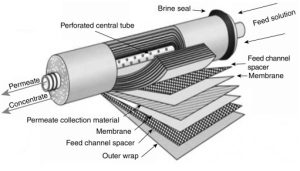Reverse osmosis (RO) membranes play a key role in wastewater treatment units as they are used to remove salts and other pollutants effectively. RO membrane performance is affected by many different factors such as feed characteristics and operational parameters during operation.
RO membranes are typically capable of removing 90%–99% of contaminants such as total dissolved solids (TDSs) in the water supply. The membranes are usually manufactured as a flat sheet of thin composite membranes consisting of an active polyamide layer (high permeability but impermeable to dissolved salts and particulate matter) supported by a porous polysulphone layer wound round a central collection tube (see Fig.).

Osmosis occurs when two solutions with different concentrations are separated by a semipermeable membrane. In RO water purification systems, the osmotic pressure is overcome using hydraulic pressure, which is applied using a pump to the concentrated side. Water is then driven from the concentrated solution and collected downstream of the membrane.
RO membranes are sized on their water volume production rate and the desired hourly or daily rate of water to be used.
The main brand that we deal with for membranes are:


